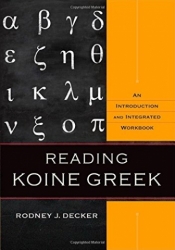Introduction
Reading Koine Greek: An Introduction and Integrated Workbook is a unique Greek textbook because it takes into account most of the advances in the study of linguistics and Greek in the past few decades.
While I would be hesitant to use this as the first Greek book for students, I think it is the best available ‘second-first’ Greek book. What do I mean by that? I encourage students after they are done with their first Greek textbook that they should supplement it with the information in Decker’s book.
In other words, on the second run-through, if a student has lost some of their Greek, or if they are simply brushing up, Decker corrects and clarifies some of the simplicity that is found in other introductory textbooks. This also makes it an ideal book for both teachers and students to supplement their material if they are using another textbook.
So what makes this book the best ‘second-first’ Greek book, and what keeps me from immediately switching to it in my classroom? Below I list the strengths and the weaknesses of the book. Because I use Mounce, I will be comparing it at times to his introductory book.
Strengths
- The strengths of Decker’s book are manifold.
- It quickly lets students get to verbs. By the fifth chapter they are learning verbs and quickly entering the basics of the Greek language.
- It is unique in that the vocabulary words are given “definitions” and then “glosses.” I find this very helpful in showing students that languages don’t have a one-to-one correspondence between words. Definitions more fully describe the word, and then possible glosses are used for memorization. Keeping this structure throughout the book helps students avoid early sophomoric mistakes.
- It also includes multiple snapshots of lexicons, ancient texts, and other helpful information for students to use in their study. This is a huge favor as sometimes professors skip over this material or forget to mention how to use these resources.
- It uses the LXX, Pseudepigrapha, and Apostolic Fathers more extensively so that students must learn the grammar and not just rely on their English Bible memory.
- It contains an extended passage for translation at the end of each chapter. For example, at the end of chapter 5 students are asked to translate John 15:1–8. Although the combination of having practice exercises and reading passages resulted in a longer textbook, the benefit is that a student will not need to buy an additional workbook.
- It contains modern insights into the Greek verbal system. This includes the aspectual value and function of the Greek verb (following Stanley Porter’s perspective on verbal aspect) and the voice system (i.e., rejection of deponency).
- It includes modern discussions such as whether to translate αδελφος as brother or “brother and sister.”
- It includes more information on English grammar in each chapter. This is becoming more and more of a need as grammar is not as emphasized in the current school system.
- It includes many teaching tips in the footnotes to help teachers with ideas for memorization.
Weaknesses
- Decker’s book also suffers from a few weaknesses.
- Although the integrated workbook allows students not to buy another book, I actually think the separation between the textbook and workbook helps students.
- It also seems to me that Mounce’s workbook is more helpful for introductory students than Decker’s. Sometimes I felt that Decker forgot what it was like to start with Greek.
- The integrated workbook itself also does not seem to allow for enough space at times for it to actually function as workbook.
- The size of the book is a little too long (703 pages) and this is because he allows for more nuanced discussions than Mounce. This means that it encroaches on intermediate grammars. While this is a strength it is also a weakness and may scare away students.
- Although the book at times has an attractive layout, it ends up being too busy and not ordered enough especially in regard to the workbook. The “Now You Try It” sections seem buried. When constructing a Greek book, the publisher and author need to consider that students will be returning to this material repeatedly and therefore it is imperative that they design the book for both the eye and the mind.
Conclusion
For all these reasons I will be keeping this book close at hand but not using it for my introductory book. At the beginning of this semester I held up the book and encouraged students who found Mounce unclear to supplement their reading with Decker. I also encouraged them to give a quick run through of Decker’s book after they have completed Mounce. I think Decker has provided a very good resource for future Greeklings, but the style of the workbook has significant drawbacks for those first being introduced to the subject.
